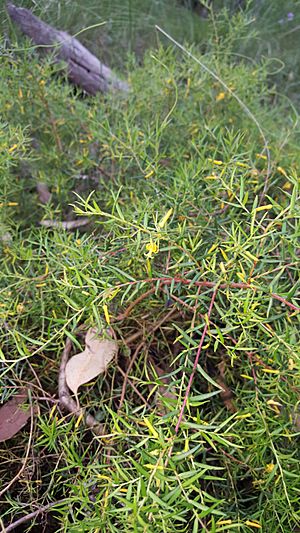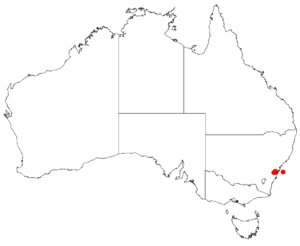Bargo geebung facts for kids
Quick facts for kids Bargo geebung |
|
|---|---|
 |
|
| Conservation status | |
| Scientific classification | |
| Genus: |
Persoonia
|
| Species: |
bargoensis
|
 |
|
| Occurrence data from Australasian Virtual Herbarium | |
The Bargo geebung (scientific name: Persoonia bargoensis) is a special flowering plant. It belongs to the Proteaceae family, which has many unique plants from Australia. This plant only grows in a small part of New South Wales, Australia. It is a straight, upright shrub with long, narrow leaves. Its flowers are yellow and shaped like tubes, and its fruits are green and look like small pears.
Contents
What Does the Bargo Geebung Look Like?
The Bargo geebung is a bushy shrub that stands upright. It usually grows to be about 0.6 to 2.5 meters (2 to 8 feet) tall. Its young branches have a few brownish hairs.
Leaves and Flowers
- The leaves grow one after another along the stems.
- They are long and narrow, like a spearhead, measuring 8 to 24 millimeters (0.3 to 0.9 inches) long.
- The leaves are also 1 to 2.3 millimeters (0.04 to 0.09 inches) wide.
- The underside of the leaves is a lighter color.
The flowers are yellow and shaped like tubes. They grow in groups of up to twenty. These groups can be found where leaves meet the stem or at the ends of branches. Each flower sits on a small stalk called a pedicel, which is 3 to 7 millimeters long. The yellow flower parts, called tepals, are 7 to 10 millimeters long.
When Does it Flower and Fruit?
Bargo geebung flowers bloom from December to January. After flowering, the plant produces green, pear-shaped fruits. These fruits are a type of drupe and can grow up to 12 millimeters (0.5 inches) long.
How Was the Bargo Geebung Named?
The Bargo geebung was officially described in 1991. Two botanists, Peter Weston and Lawrie Johnson, gave it its scientific name, Persoonia bargoensis. They worked at the National Herbarium of New South Wales. They found the plant near Douglas Park in 1989.
Understanding Its Family Tree
At first, they thought this plant might be a mix between two other Persoonia species. One of these, Persoonia nutans, grows about 40 kilometers (25 miles) north. The other, P. oxycoccoides, grows 25 kilometers (16 miles) south. But after more study, they found it was a unique species.
P. bargoensis belongs to a group of 58 similar Persoonia species called the Lanceolata group. These species have similar flowers but very different leaves. They can sometimes interbreed if they grow near each other.
Where Does the Bargo Geebung Live?
The Bargo geebung grows in small, scattered areas in New South Wales. This area is bordered by:
- Picton and Douglas Park to the north.
- Yanderra to the south.
- Cataract River to the east.
- Thirlmere to the west.
It grows on soils made from Sydney sandstone and Wianamatta shale. These areas are usually 100 to 300 meters (330 to 980 feet) above sea level.
Its Home Environment
This plant likes to grow in dry sclerophyll eucalypt forests. It can be found under trees like:
- Forest red gum (Eucalyptus tereticornis)
- Broad-leaved red ironbark (E. fibrosa)
It often grows with a grassy understory of kangaroo grass (Themeda triandra). It also thrives in more open woodlands with trees such as:
- Red bloodwood (Corymbia gummifera)
- Scribbly gum (Eucalyptus sclerophylla)
- Grey gum (E. punctata)
- Narrow-leaved stringybark (E. sparsifolia)
- Small-leaved apple (Angophora bakeri)
In these open areas, there's often a shrubby understory with plants like wreath bush-pea (Pultenaea tuberculata). Interestingly, the Bargo geebung often grows well along road verges. This is because there is more light and fewer other plants competing for space.
Why is the Bargo Geebung Protected?
The Bargo geebung is a special plant that needs protection.
- The Australian Government lists it as "vulnerable" under the Environment Protection and Biodiversity Conservation Act 1999. This means it faces a high risk of becoming endangered in the future.
- The New South Wales Government lists it as "endangered" under the Biodiversity Conservation Act 2016. This means it is at very high risk of disappearing.
Main Threats
There are a few main reasons why this plant is at risk:
- Small Population: There are not many Bargo geebung plants left.
- Habitat Loss: The places where it naturally grows are being destroyed or changed.
- Habitat Fragmentation: Its living areas are being broken up into smaller, separate pieces. This makes it harder for plants to spread and grow.
- Poor Maintenance: Some activities, like roadside clearing, can harm the plants if not done carefully.
Protecting the Bargo geebung helps keep this unique part of Australia's nature safe for the future.


